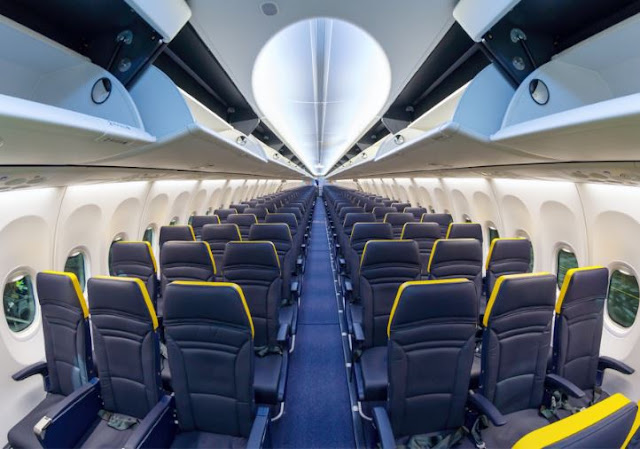Boeing 737-800 Next-Generation Specs, Interior, Cockpit, and Price – The Boeing 737-800 is a medium sized twin engine aircraft that belongs to the Boeing 737 Next-Generation (NG) family. This aircraft is the basis for Boeing Business Jet 2 (BBJ2). The 737-800ERX variant was chosen as the fuselage for the new US Navy Multi-Mission Maritime (MMA) aircraft, designated by P-8A, in June 2004. It became one of the best-selling types of jet aircraft of all time.
The first flight for the Boeing 737-800 took place in February 1997. The aircraft entered service with Hapag-Lloyd launch customers in 1998. This aircraft can fly farther and accommodate more passengers than the previous version. The Boeing 737-800 was built to compete primarily with the Airbus A320.

The Boeing 737-800 aircraft landing system is a landing gear that can be hydraulically pulled on a tricycle type. The gears are equipped with oleo-pneumatic shock absorbers designed by Boeing. The main wheel pulls in with the wheels forming a well seal; the well has no door. The main wheels are equipped with Honeywell or Goodrich wheel brakes. Twin nose wheel pulled forward.
Noise on the ground is reduced to 12 dB by installing a new diffuser channel and dampers on the cooling vents on additional power units. A new quiet operating fan has been installed in the environmental control system and in the electronic cooling system.
Boeing 737-800 can fly with a maximum speed of 876 km / h and a cruising speed of 842 km / h. The capacity of the fuel that can be carried by the aircraft is 26,025 l. The aircraft has an empty weight of 41,413 kg and a maximum take-off weight of 79,010 kg. The aircraft can cover a range of up to 2,935 nmi (5,436 km).


Boeing 737-800 cockpit has also been equipped with Head Up Display (HUD). This equipment is usually used on military aircraft / combat aircraft. Its function is to facilitate the pilot in determining the plane's tilt both vertically and horizontally. In addition, this aircraft can be equipped with an optional global positioning system, satellite communications, and dual flight management systems.
The first flight for the Boeing 737-800 took place in February 1997. The aircraft entered service with Hapag-Lloyd launch customers in 1998. This aircraft can fly farther and accommodate more passengers than the previous version. The Boeing 737-800 was built to compete primarily with the Airbus A320.

Boeing 737-800 Next-Generation Specs
The Boeing 737-800 fuselage was built using safe aluminum material. The aircraft wing has a fail-safe design with an aluminum alloy structure with corrosion resistant leather. Nosecone fairing, wings and fuselage, fin tips, fairing of flap actuators and other non-pressure components are constructed of glass fiber and carbon reinforced plastic (GFRP and CFRP). The back of the engine nacelles is built from graphite, Kevlar and glass fiber composites. Overall, the dimensions of the Boeing 737-800 include 39.5 m in length, 12.5 m in height, and 35.8 m in wingspan.The Boeing 737-800 aircraft landing system is a landing gear that can be hydraulically pulled on a tricycle type. The gears are equipped with oleo-pneumatic shock absorbers designed by Boeing. The main wheel pulls in with the wheels forming a well seal; the well has no door. The main wheels are equipped with Honeywell or Goodrich wheel brakes. Twin nose wheel pulled forward.
Boeing 737-800 Next-Generation Engine and Performance
The Boeing 737-800 is powered by two CFM56-7B24 International CFM turbofan engines, each of which produces a thrust of 110 kN to 120 kN. Each engine is mounted on a pod engine under the wing. The aircraft is equipped with an additional Honeywell 131-9B power unit, which provides 90 kVA and air start capability.Noise on the ground is reduced to 12 dB by installing a new diffuser channel and dampers on the cooling vents on additional power units. A new quiet operating fan has been installed in the environmental control system and in the electronic cooling system.
Boeing 737-800 can fly with a maximum speed of 876 km / h and a cruising speed of 842 km / h. The capacity of the fuel that can be carried by the aircraft is 26,025 l. The aircraft has an empty weight of 41,413 kg and a maximum take-off weight of 79,010 kg. The aircraft can cover a range of up to 2,935 nmi (5,436 km).

Boeing 737-800 Next-Generation Cabin and Interior
The Boeing 737-800 cabin can accommodate 162 passengers in a two-class configuration, usually arranged with four first class passengers following and six tourist class passengers following. The maximum capacity that can be accommodated by the cabin is 189 seats. Air-conditioned cab with an air cycle environmental control system. Airstairs is optional for the front cabin, which allows the aircraft to operate in an airport measuring conveyor.
Boeing 737-800 Next-Generation Cockpit and Avionics
The Boeing 737-800 cockpit accommodates pilot and co-pilot. The new cockpit is equipped with a Common Display System (CDS) from Honeywell Air Transport Systems which combines six flat panel liquid crystal displays. The CDS software can be programmed to enable the presentation of data in the replication format of the main Boeing 777 electronic flight system and navigation display.Boeing 737-800 cockpit has also been equipped with Head Up Display (HUD). This equipment is usually used on military aircraft / combat aircraft. Its function is to facilitate the pilot in determining the plane's tilt both vertically and horizontally. In addition, this aircraft can be equipped with an optional global positioning system, satellite communications, and dual flight management systems.








Hello sir Do you have a A330 for sale
ReplyDelete